|
Back
to Illustrated Sites of Greece
Castalian
Spring
Corycian
Cave and Environs
Marmara
at Delphi
The Delphi
Museum Gallery
Mount
Parnassos
Up the
Sacred Way
The Stadium at
Delphi
The Temple of
Apollo
The Theater at
Delphi
|
 |
|
Dr. J's Illustrated Temple of Apollo
at Delphi |
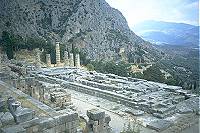 The
temple as it survives dates only to the fourth century BC, but the foundation is original
to an earlier version from the sixth century, which replaces an even older seventh century
version. There would have been two rows of Ionic columns forming an interior colonnade
within the Doric peripteral temple (6 X 15 columns). The pedimental sculpture described by
Pausanias has never been found. The
temple as it survives dates only to the fourth century BC, but the foundation is original
to an earlier version from the sixth century, which replaces an even older seventh century
version. There would have been two rows of Ionic columns forming an interior colonnade
within the Doric peripteral temple (6 X 15 columns). The pedimental sculpture described by
Pausanias has never been found. |
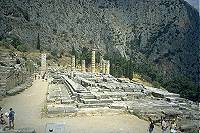 Ancient
authors admired the sixth century temple and honored it with their art: Euripides' Ion is
set in front of the temple of Apollo; Orestes comes to this very temple in his flight from
the Furies in the third play of Aeschylus' Oresteia; and Pindar actually wrote his Hymn to
Apollo while sitting inside on an iron chair. It is recorded that the Greek maxim
"Know thyself" was etched into one of the interior walls. Ancient
authors admired the sixth century temple and honored it with their art: Euripides' Ion is
set in front of the temple of Apollo; Orestes comes to this very temple in his flight from
the Furies in the third play of Aeschylus' Oresteia; and Pindar actually wrote his Hymn to
Apollo while sitting inside on an iron chair. It is recorded that the Greek maxim
"Know thyself" was etched into one of the interior walls. |
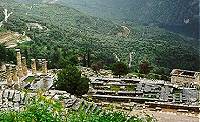 The
stylobate and many pavement stones have been replaced on the 3-step blue limestone
foundation. Nobody knows the arrangement of the adyton, or inner shrine that housed the
sacred tripod of Apollo and the sacred chasm from which spewed forth sacred godly
emanations. When the French excavated, they bore down to the bedrock without finding the
secret chamber wherein the priestess would have become inebriated with the spirit of
Apollo. Arguments abound about that too: some say the priestess chewed laurel leaves
(sacred to Apollo) to become god-inspired; de-mystifiers suggest that a fumarole since
closed by an earthquake vomited forth intoxicating fumes from the earth's center. This
last idea might not be so far-fetched, since the Earth Goddess Gaia was worshipped here,
too. The
stylobate and many pavement stones have been replaced on the 3-step blue limestone
foundation. Nobody knows the arrangement of the adyton, or inner shrine that housed the
sacred tripod of Apollo and the sacred chasm from which spewed forth sacred godly
emanations. When the French excavated, they bore down to the bedrock without finding the
secret chamber wherein the priestess would have become inebriated with the spirit of
Apollo. Arguments abound about that too: some say the priestess chewed laurel leaves
(sacred to Apollo) to become god-inspired; de-mystifiers suggest that a fumarole since
closed by an earthquake vomited forth intoxicating fumes from the earth's center. This
last idea might not be so far-fetched, since the Earth Goddess Gaia was worshipped here,
too. |
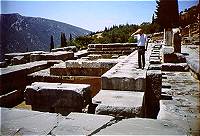 The oracle was very wealthy and very powerful, and, some would
argue, very corrupt. First, the oracle gave answers to questions concerning military
escapades in riddles. For example, the Lydian King, Croesus, might not have been so
satisfied with the news that "a great empire would fall" after his battle with
the Persians had he known that great empire would be his own. Secondly, how hard is it to
forecast military defeat or victory if you are the confidant of all interested parties -
all of whom have divulged their military secrets to you? The oracle was very wealthy and very powerful, and, some would
argue, very corrupt. First, the oracle gave answers to questions concerning military
escapades in riddles. For example, the Lydian King, Croesus, might not have been so
satisfied with the news that "a great empire would fall" after his battle with
the Persians had he known that great empire would be his own. Secondly, how hard is it to
forecast military defeat or victory if you are the confidant of all interested parties -
all of whom have divulged their military secrets to you? |
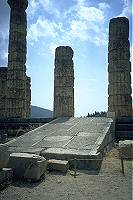 On the
east side of the Temple of Apollo lies the Great Altar, or the Altar of the Chians,
originally dedicated by the population of the island of Chios (after their successful
stand against the Persians) and restored in 1920 by their modern descendants.
Unfortunately, this is not a picture of the altar - the oldest bichromatic (black and
white) building found anywhere; this is just the stone ramp leading from the altar to the
east entrance of the temple. On the
east side of the Temple of Apollo lies the Great Altar, or the Altar of the Chians,
originally dedicated by the population of the island of Chios (after their successful
stand against the Persians) and restored in 1920 by their modern descendants.
Unfortunately, this is not a picture of the altar - the oldest bichromatic (black and
white) building found anywhere; this is just the stone ramp leading from the altar to the
east entrance of the temple. |
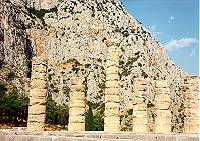  These
reconstructed 4e columns tower over the site. Note the bird sitting atop the
only fully reconstructed column (right). We can only imagine the commanding presence this
temple must have enjoyed, completely surrounded by such columns and perched on the very
precipice of Mt. Parnassos, surrounded by hundreds of votives... These
reconstructed 4e columns tower over the site. Note the bird sitting atop the
only fully reconstructed column (right). We can only imagine the commanding presence this
temple must have enjoyed, completely surrounded by such columns and perched on the very
precipice of Mt. Parnassos, surrounded by hundreds of votives... |
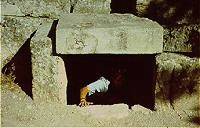  Coming out of one of the drains that run
underneath the Temple of Apollo (in '95 and '98). Although the French archaeologists
failed to find the secret chamber where the Pythia communed with Apollo, this passageway
allowed us to hide ourselves within the bowels of the temple. Probably against the rules,
but well worth the risk. While we were inside, a tourist group from Britain gathered
around the Temple and posed the Oracle a question. It was really hard to resist answering
...so we didn't! Coming out of one of the drains that run
underneath the Temple of Apollo (in '95 and '98). Although the French archaeologists
failed to find the secret chamber where the Pythia communed with Apollo, this passageway
allowed us to hide ourselves within the bowels of the temple. Probably against the rules,
but well worth the risk. While we were inside, a tourist group from Britain gathered
around the Temple and posed the Oracle a question. It was really hard to resist answering
...so we didn't! |
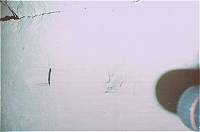 In the pitch-black drain, I took this over-exposed flash photo
of a lifting block. The builders threaded a rope through this horse-shoe tunnel drilled
into the rock in order to move it into position. This was a tight spot - the drain is a
rectangular space not wide enough for any turning or shifting of position (not for the
claustrophobic!) and certainly not wide enough to juggle camera and flashlight! In the pitch-black drain, I took this over-exposed flash photo
of a lifting block. The builders threaded a rope through this horse-shoe tunnel drilled
into the rock in order to move it into position. This was a tight spot - the drain is a
rectangular space not wide enough for any turning or shifting of position (not for the
claustrophobic!) and certainly not wide enough to juggle camera and flashlight! |
|
